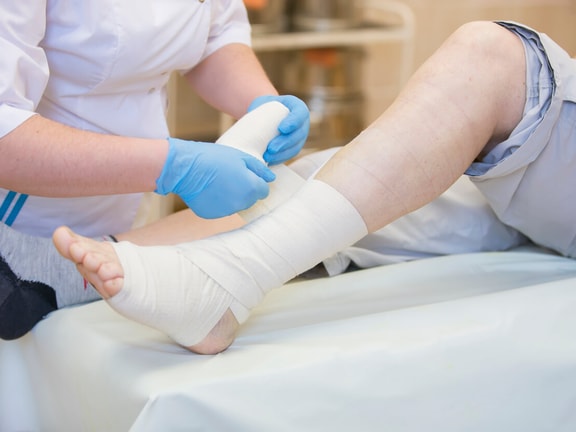Unna Boot Application: Technique, Indications, and Use in Wound Care
August 1, 2025
7 min. read

Chronic venous insufficiency and venous leg ulcers remain a persistent challenge in home health and outpatient care. Compression therapy, particularly through the use of Unna boots, plays a valuable role in supporting venous return, managing edema, and promoting healing of lower extremity wounds. The Unna boot—a paste-impregnated gauze bandage—is a widely used, time-tested intervention.1
Proper Unna Boot application is key to optimizing therapeutic outcomes, avoiding complications, and maintaining alignment with wound care protocols. In this article, we’ll review what an Unna Boot is, when and how to apply it, and how it supports care delivery in the home health setting. For organizations standardizing education, developing a downloadable Unna boot application PDF can be a valuable tool to complement this guidance.
What is an Unna boot?
An Unna boot is a non-elastic compression dressing made of gauze impregnated with zinc oxide paste. Some products may also include calamine, glycerin, or other additives to help protect the skin. When applied, the dressing hardens slightly and provides moderate graduated compression that supports venous return while allowing patients to remain mobile.
The Unna boot is commonly used for:
Venous stasis ulcers
Chronic lower extremity edema
Wound healing in the presence of chronic venous insufficiency
Post-traumatic swelling and localized inflammation
Because of its semi-rigid structure, the boot aids the calf muscle pump mechanism during ambulation and helps prevent pooling of blood in the lower extremities.
Key characteristics include:
Provides approximately 20–30 mmHg of compression2
Usually changed every 3–7 days depending on wound status
Supports mobility and comfort without elasticity
Unna Boot Application Step by Step Guide
Submit a few brief details to unlock your Unna Boot Application Step by Step Guide

Indications and contraindications
Not every patient with a lower extremity wound is an appropriate candidate for Unna boot therapy. Careful screening—grounded in evidence and guided by clinical expertise—helps identify when the intervention will be most effective and when it may pose unnecessary risk.
Indications
Unna boot application is appropriate in the management of:
Venous leg ulcers with moderate to heavy exudate
Chronic edema from venous disease
Select cases of controlled lymphedema
Contraindications
Use of an Unna boot is not appropriate for:
Significant arterial insufficiency (ABI < 0.5)
Active infections requiring drainage
Acute deep vein thrombosis
Peripheral neuropathy with impaired sensation
Allergy to zinc oxide or other paste ingredients
Clinicians should evaluate arterial flow using Doppler ultrasound or ankle-brachial index (ABI) testing prior to compression therapy. Standard compression is generally considered safe with an ABI ≥ 0.8, modified or lighter compression may be considered with caution between 0.5 and 0.8, and compression should be avoided entirely if ABI is below 0.5.3,4
How to apply an Unna boot
Applying an Unna boot is more than a routine dressing change—it’s a skilled procedure that requires careful attention to circulation, skin integrity, and wound healing goals. Proper technique helps prevent pressure injuries, maintain perfusion, and create the optimal environment for healing.
The following method outlines the standard approach to Unna boot application.
Supplies needed
Zinc oxide-impregnated gauze roll (Unna boot)
Optional cotton padding or stockinette
Secondary cohesive wrap or compression bandage
Wound care supplies
Gloves, scissors
Before you begin
Verify provider orders and the plan of care to confirm compression therapy is appropriate.
Introduce the procedure to the patient and caregiver, confirm understanding, and obtain consent.
Follow infection control practices, including hand hygiene, gloves, and a clean setup.
Assess the skin and wound for changes that may affect care.
Application steps
Clean and prepare the skin: Cleanse the wound following protocol. Apply topical ointments or primary dressings as ordered. Protect the periwound area with a barrier film if needed.
Wrap the Unna boot: Starting at the base of the toes, wrap the impregnated gauze with light tension in a spiral or figure-eight pattern, overlapping by 50 percent as you move up the leg. Continue wrapping to just below the knee.2
Smooth and secure: Gently press and smooth the bandage to eliminate air pockets and wrinkles. Avoid tight constriction over bony prominences such as the ankle or shin. Apply a secondary cohesive bandage to hold the Unna boot securely in place.
Post-application check: Assess for adequate blood flow. Toes should remain warm, pink, and demonstrate brisk capillary refill. Document the date, time, wound characteristics, and patient tolerance.
Unna Boot application is often incorporated into interdisciplinary wound care protocols. To reduce variation in practice and ensure safe, consistent outcomes, many organizations provide a standardized Unna boot application PDF as part of staff education and in-field training.
Example use: Unna boot in home health
A home health nurse visits a patient with a history of recurrent venous ulcers and chronic lower leg edema. During the assessment, the nurse observed a shallow ulcer over the medial ankle, with surrounding hemosiderin staining and mild erythema. An ankle-brachial index of 0.95 confirms adequate arterial circulation and no signs of infection.
With the physician’s order in place, the nurse cleanses the wound, applies a protective barrier to the periwound skin, and wraps the leg with an Unna boot from the base of the toes to just below the knee. A cohesive wrap is added for stability and additional compression. Before leaving, the nurse educates the patient on keeping the dressing dry, elevating the leg when resting, and reporting any new pain, numbness, or color changes.
Over the next three weeks, the nurse returns every four days to change the dressing and reassess the wound. Each visit shows measurable progress: less drainage, gradual reduction in wound size, and improved comfort during ambulation.
This scenario reflects the practicality of Unna boot therapy in the home health setting—particularly when paired with thorough assessment, patient education, and consistent reassessment.
Maintenance and monitoring
Ongoing monitoring is critical to ensure Unna boot therapy remains safe and effective. Patients and caregivers should be educated on key aspects of at-home management:
Mobility: Encourage regular walking to activate the calf muscle pump and improve venous return.
Elevation: Instruct patients to elevate the legs above heart level while resting to reduce edema.
Moisture protection: Stress the importance of keeping the boot dry. A protective cover can be used while bathing.
Symptom reporting: Patients should be advised to report increased pain, tingling, numbness, skin discoloration, or signs of infection promptly.
The boot should typically be replaced every three to seven days. If saturation occurs sooner or if signs of skin breakdown develop, earlier reassessment may be needed. Clinical staff should monitor the wound site, check for proper compression, and reassess arterial sufficiency on a regular basis. Clinicians should also document each dressing change, wound appearance, and patient tolerance, and promptly communicate any concerns or abnormalities to the referring provider.
Organizations looking to standardize these follow-up practices often use an unna boot application PDF as a staff education tool or in clinical documentation training.
Key takeaways for clinicians
Unna boot application is a practical, evidence-based method for delivering compression therapy in patients with venous leg ulcers and chronic edema. Its semirigid design supports mobility while improving venous return, making it a valuable tool in both home health and outpatient care.
Optimal outcomes depend on three key factors: thorough assessment before initiation, correct application technique, and routine monitoring during follow-up. When applied consistently and safely, the Unna Boot can help reduce symptoms, promote wound healing, and improve patient quality of life.
For more step-by-step guidance and competency-based training, explore the Medbridge Clinical Procedure Manual. This on-the-go resource delivers expert-reviewed instructions, safety checks, and video demonstrations designed to support home health clinicians at the point of care.
References
Cardoso, L. V., Godoy, J. M. P., Godoy, M. F. G., & Czorny, R. C. N. (2018). Compression therapy: Unna boot applied to venous injuries: an integrative review of the literature. Terapia compressiva: bota de Unna aplicada a lesões venosas: uma revisão integrativa da literatura. Revista da Escola de Enfermagem da U S P, 52, e03394. https://pubmed.ncbi.nlm.nih.gov/30517291/
Medbridge. (2024). Unna Boot: Step-by-step guide (Clinical Procedure Manual). https://www.medbridge.com/educate/courses/unna-boot-kim-tate
McCullough, C. J., & Kloth, L. C. (2012). Ankle brachial index: Quick reference guide for clinicians. Journal of Wound, Ostomy and Continence Nursing, 39(2S), S21–S29. https://journals.lww.com/jwocnonline/Fulltext/2012/03001/Ankle_Brachial_Index__Quick_Reference_Guide_for.6.aspx
Shabani Varaki, E., Golabchi, A., & Mohajeri-Tehrani, M. R. (2023). Ankle Brachial Index. In StatPearls. StatPearls Publishing. https://www.ncbi.nlm.nih.gov/books/NBK544226/

